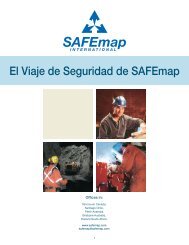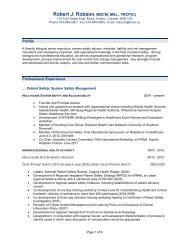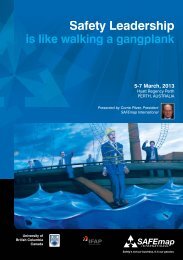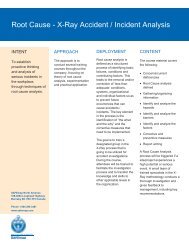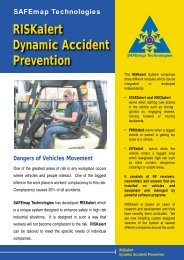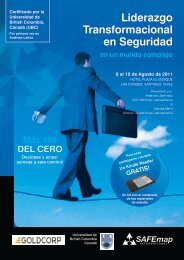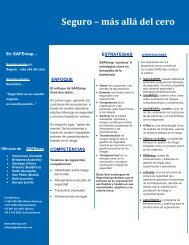A Matter of Perception - SAFEmap International
A Matter of Perception - SAFEmap International
A Matter of Perception - SAFEmap International
Create successful ePaper yourself
Turn your PDF publications into a flip-book with our unique Google optimized e-Paper software.
A <strong>Matter</strong> <strong>of</strong> <strong>Perception</strong>By Mark SabourinOHS Canada April/May 2000Question for CEO: If there was a tool that would let you find out whatyour employees really believe about the company’s health and safetyperformance, would you dare to use it?“In my workplace, if I mention a possible safety problem to my boss, I can restassured that he or she will do whatever it takes to fix the problem as quicklyas possible.” In your opinion, is this statement true? Score three for “alwaystrue”, two for “usually true”, one for “sometimes true” and zero for “never true”.Welcome to perception surveys.Corrie Pitzer is the Managing Director <strong>of</strong> <strong>SAFEmap</strong>, an Australian companyspecialising in the analysis <strong>of</strong> corporate culture, and a leading internationalexponent <strong>of</strong> perception surveys as the tool <strong>of</strong> choice for measuring workplacesafety. “Quite <strong>of</strong>ten” says Pitzer “management tries to impose a culture on anorganization with mission statements and value statements.” It seldom works.Culture, especially safety culture, develops not in the corporate <strong>of</strong>fice, but inthe workplace where the people do the work, he says. When a companybegins taking a serious look at its safety culture, it is <strong>of</strong>ten surprised by what itfinds."In my experience," says Pitzer, "there is a considerable ‘disconnect’ betweenwhat management thinks happens down there and what employees knowhappens down there. When the results come in, what they show is <strong>of</strong>ten quitefascinating.Or very disturbing.A perception survey is essentially an audit, a measurement tool that can beused to gauge the state, condition or level <strong>of</strong> safety (or quality, or morale oralmost anything else) in the workplace.<strong>Perception</strong> surveys differ radically from the more conventional audit tools.Physical audits look at equipment. Systems audits look mostly in the filingcabinet in the <strong>of</strong>fice for things like policies, procedures and records. Thetraditional walk-around and-chat routine that <strong>of</strong>ten accompanies both <strong>of</strong> theseaudits will record spot impressions - spot impressions <strong>of</strong> how a worker willperform when he's being watched and spot impressions <strong>of</strong> what a worker willtell an auditor.Physical and systems audits can go only so far. They measure what's there,but they do not necessarily measure whether what's there is working.
A perception survey measures how the people in the workplace perceive thesituation, it records what they believe to be true, it gauges opinion, outlookand attitude. In other words, it measures the "culture" or the operative realityin the workplace.Safety culture has the sound <strong>of</strong> one <strong>of</strong> those touchy-feely concepts that makeconsultants rich and the rest <strong>of</strong> us sigh or cringe. Dave Lafortune, who is asenior adviser for corporate health and safety with Ontario Power Generation,seems almost apologetic when he explains that safety culture has nothing todo with the high-sounding declarations <strong>of</strong> corporate principles that one <strong>of</strong>tenfinds framed and polished on corporate lobby walls.True versus real“ If I do my job the way that I was shown in training, and if I follow all the safetyrules, I will have no trouble meeting the production levels that are expected <strong>of</strong>me.” In your opinion, is this statement true? Score three for “always true”, tw<strong>of</strong>or “usually true”, one for “sometimes true” and zero for “never true”.The concept <strong>of</strong> corporate culture made wealthy men <strong>of</strong> folks like Tom Peters,Robert Waterman, Terrence Deal and Allan Kennedy, whose books defined itas the set <strong>of</strong> shared values and beliefs held by an organisation.It's a fuzzy concept, one that Pitzer says is difficult, maybe even impossible, tomeasure. What can be measured, he says, is how people behave, how theyperceive their own behaviour and how they perceive that <strong>of</strong> others. Somepeople call this "safety climate" rather than "safety culture" Whatever onechooses to call it, when Ontario Power Generation and the Australian miningindustry set out to understand the relationship between work and safety asseen by the workers themselves, they did so by using perception surveys.It's difficult to tell to what extent companies are looking at safety culture aspart <strong>of</strong> their corporate safety initiatives. It's still a new concept. Broadorganization-wide surveys <strong>of</strong> corporate perceptions have been around sinceat least the 1980s, says Pitzer, but the results <strong>of</strong> those surveys have givenlittle <strong>of</strong> value to safety managers. The narrowly focused safety culture surveyis a much newer addition to the safety manager's tool kit, and Ontario PowerGeneration and the Australian mining industry are among the few who daredto use it.There are others, <strong>of</strong> course, who have looked or who will soon be looking atsafety culture but who are reluctant to talk about it. It's not difficult tounderstand why. Corporate culture, mission statements, statements <strong>of</strong> corevalues and similar pronouncements have become part <strong>of</strong> a corporation'spublic face. Corporations use them to define themselves to the outside world.Heather Harvey, director <strong>of</strong> human resources and environmentalmanagement at the Woodbridge Group, says her employer prefers to spendits time talking about safety culture and reinforcing it rather than surveying it."Culture is seen in the way in which we behave and in the attitudes we haveas individuals and in groups throughout the organization," she says.
Dave Shier, a health and safety staff <strong>of</strong>ficer with the Power Workers' Union,says his union is both participating in and supporting Ontario PowerGeneration's survey efforts. The true test, he says, will be the results andwhat the employer chooses to do with them."If you say the problem with safety is that people aren't careful, that's ‘blamethe worker’ says Lafortune. "If you say the problem is the work environment,that's the opposite."In effect, the concept <strong>of</strong> safety culture redefines the term “work environment”to include the whole range <strong>of</strong> attitudes and beliefs around work and safety,most <strong>of</strong> which are products <strong>of</strong> the workplace.It boils down to the difference between what is "true" and what is "real". In ahealthy corporate safety culture, the words "true" and " real" mean the samething. In effect, it doesn't much matter what is "true"; it matters what thepeople doing the work believe is true, because it is the belief that they will actupon.The perception survey is designed to discover what the people in theworkplace believe is true, and whatever they believe and act upon, that'swhat's real.We can also go a long step further. What the people in the workplace - theworkers, their supervisors and their managers - believe is real defines theculture <strong>of</strong> that workplace. That culture permeates the space like the aireveryone breathes. A new worker entering the workplace will breathe the air,absorb the culture and act in ways that are consistent with that culture.Gut reaction“If I were to decide to do something that everyone knows is risky, the people Iwork with would come and tell me to stop”In your opinion, is this statement true? Score three for “always true”, two for“usually true”, one for “sometimes true” and zero for “never true”.In Australia, the mining industry knew it had a safety problem. Accidentfrequency was falling, explains Dick Wells, executive director <strong>of</strong> the MineralsCouncil <strong>of</strong> Australia, a national umbrella group for the industry, but fatalitieswere not. In 1996, a particularly grim year, 33 miners died.The industry collectively set an ambitious target: a mining industry free <strong>of</strong>accidents, illness and fatalities, and set a course to make it happen. Part <strong>of</strong>that course was attacking what Wells calls "the bottom increment" <strong>of</strong> accidentstatistics: those accidents that seemed to occur despite implementation <strong>of</strong>what he describes as some <strong>of</strong> the best safety systems in the world.An ambitious undertaking like eliminating all accidents and illness from theAustralian mining industry required an ambitious examination <strong>of</strong> safety
culture. The survey, managed by Corrie Pitzer and his colleagues at<strong>SAFEmap</strong>, sampled the perceptions <strong>of</strong> more than 7000 people employed inthe country’s mining industry.The method used was a mixture <strong>of</strong> conventional and high-tech. Pitzer and hisgroup gathered respondents in small groups, armed them with electronicdevices on which to record their agreement and disagreement, and read thema series <strong>of</strong> positive and negative statements. The advantage <strong>of</strong> the method,says Pitzer, is that responses are not influenced by literacy and the processrecords the respondent's initial "gut reaction" to the statement.The Minerals Council <strong>of</strong> Australia bravely proclaims that the results, releasedin July, 1999, were not surprising. It also concedes that good news was hardto find.The vision <strong>of</strong> a minerals industry free <strong>of</strong> accidents and illness had beenembraced by senior management, the survey showed, but the closer one gotto the coal-face, the less credible that vision became. Among operators - theworkers most at risk - there continues to prevail a culture <strong>of</strong> risk-taking and afatalistic resignation to the inevitability <strong>of</strong> accidents.The grim backdrop to the survey's findings is the body count. In the first twoquarters <strong>of</strong> the 1999-2000 reporting year, there had already been eightfatalities in the Australian mining industry.Dave Lafortune understands well the Australian mining industry's concern withsafety culture. Ontario Power Generation's safety culture survey is a morerecent initiative than that Down Under, but Lafortune is pinning his hopes onculture as a major predictor <strong>of</strong> health and safety performance.Lafortune bases his belief partly on a recently concluded study that looked atthe cultural causes <strong>of</strong> the unusually high sick-leave rate throughout thecompany. The study, though not a culture survey, nonetheless gaveLafortune strong hints that cultural issues may lie at the heart <strong>of</strong> many aspects<strong>of</strong> employee behaviour and performance.Ontario Power Generation has recently undergone a period <strong>of</strong> upheaval, saysLafortune. The future <strong>of</strong> the company, formerly an arm <strong>of</strong> Ontario Hydro, hasbeen uncertain, and the impending introduction <strong>of</strong> competition into theindustry had led to widespread concerns about job security and the value thecompany placed on its employees. The study showed a clear link betweenjob security and sick rate, says Lafortune.Lafortune is still awaiting results <strong>of</strong> a perception survey covering some 4,000workers in the non-nuclear side <strong>of</strong> the industry at Ontario Power Generation.The survey is meant to evaluate the effectiveness <strong>of</strong> new managementsystems and to provide baseline data for later research. A second survey,covering the balance <strong>of</strong> the employee population, is being designed.
Predictive value“If a piece <strong>of</strong> equipment I work with needs repair or adjustment, there issomeone I can call who will come and fix it without any hassles.” In youropinion, is this statement true? Score three for “always true”, two for “usuallytrue”, one for “sometimes true” and zero for “never true”.Organizational Studies Inc. designed Ontario Power Generation's study, butsenior consultant Gary Allen relies on anecdotal evidence only when heattributes improvements in safety performance to a strong safety culture.He likens it to capturing "the hearts and minds" <strong>of</strong> employees. If employeesfeel they are working in a safe environment, they will be more productive,motivated and satisfied, he says. That's capturing the "heart". Surveys alsoidentify specific information about narrow issues that management can actupon. That, says Allen, captures the "mind".Culture surveys help tell you where you're going, says Dick Wells. He feelsthey may be predictive <strong>of</strong> certain behaviours, risk-taking for instance. Wherehe and Pitzer clearly agree is on the value, or lack <strong>of</strong> value, <strong>of</strong> conventional"lag" indicators: statistics measuring accidents, fatalities, lost time and thelike.They have no predictive value, says Wells. Pitzer goes even further. He saysthey have no value at all."Using an accident rate to measure safety performance is the same as usinga thermometer to measure blood pressure,” says Pitzer.We've become good enough at managing safety, says Pitzer, and accidentsnow have little statistical value. Happily, for most organizations they areunusual, isolated events. "Accidents are very small events, statistically," hesays. It is what precedes the accident, the range <strong>of</strong> risk-taking activity in theworkplace that is the strongest measure <strong>of</strong> safety performance. That's whatthe perception survey considers."The most front-line measure <strong>of</strong> safety is a perception survey," he says."That’s what's really happening in an organization. Its common to find anumber <strong>of</strong> cultures within the framework <strong>of</strong> a larger corporate culture, saysLafortune. These cultures can form around work groups or within horizontalstrata <strong>of</strong> an organization. It's not necessarily a bad thing, he suggests. Oncea culture survey has identified these groups, the organization can assesswhich one’s best encourage safe behaviour and attempt to promote themelsewhere.Pitzer's research found many such cultures within the Australian miningindustry. A culture is a set <strong>of</strong> solutions produced by a group <strong>of</strong> people to meetspecific problems they face, he says. Organizations may end up with as manycultures as they have sub-units.Pitzer does not totally buy the conventional trickle-down theory <strong>of</strong> corporateculture: that strong consistent helmsmanship will eventually and inevitablytranslate into appropriate attitudes in the boiler room. Were it that simple, thesurvey <strong>of</strong> the Australian minerals industry should have yielded different
esults. There, a vision <strong>of</strong> an industry free <strong>of</strong> accidents and illness, embracedand promoted uniformly by senior management, was disbelieved and rejectedby the workers it was meant to protect. Although workers believedmanagement’s intention to reduce accidents and improve safety, they werelargely resigned to the inevitability <strong>of</strong> accidents that were, they felt, outsideanyone’s ability to influence or control.Pitzer calls this a "disconnect' " an example <strong>of</strong> culture suddenly taking a sharpturn and heading <strong>of</strong>f in an entirely unexpected direction. It may be caused bysomething as simple as one level <strong>of</strong> the corporate hierarchy failing in itsresponsibility to transmit, through action and words, the values the companyis seeking to promote. In the Australian mining industry, Pitzer points to thegrowing importance <strong>of</strong> management in the promotion <strong>of</strong> safety. This, he feels,marginalized supervisors' safety promotion role and led to a "disconnect" atthe coalface.“ The people most exposed to the risk are the operators, but the people mostinfluential over their behaviour are the supervisors,” he says.But the core <strong>of</strong> the problem may run much deeper, suggests Pitzer, and maycross national and industry boundaries. In fact he suggests the culturaldisconnect identified at the Australian coal-face will likely be found in high-riskindustries elsewhere, including Canada.“Our CEO enforces the safety policy with managers, supervisors and workersthe same way he or she enforces the expense account policy.” In youropinion, is this statement true? Score three for “always true”, two for “usuallytrue”, one for “sometimes true” and zero for “never true”.The issue is the almost inevitable conflict between safety culture andcorporate culture. Most corporate cultures today stress increasing levels <strong>of</strong>employee empowerment, says Pitzer, where initiative, bold thinking andcreative problem solving is encouraged and rewarded. Safety cultures,especially those in higher-risk industries, stress the exact opposite.Commercial safety systems <strong>of</strong>ten have little to do with empowerment, hesays. Government legislation prescribes what must or must not be done. Anddespite rhetoric about safety being a joint responsibility, ensuring a safe andhealthy workplace remains management’s duty.The result, he says, is a cultural disconnect. The safety culture becomes “howwe comply”. The corporate culture becomes “how we get the job done”, andin such an environment it almost inevitably ends in disaster.“There are no tasks in my job that cannot be performed safely every time.” Inyour opinion, is this statement true? Score three for “always true”, two for“usually true”, one for “sometimes true” and zero for “never true”.
If you examine the fatalities in the Australian mining industry, he says, you willfind that most were not the result <strong>of</strong> unusual activities. Miners are being killeddoing jobs they are skilled at and are competent to do, acting well withinaccepted procedures. But because <strong>of</strong> the workers’ skills and the strength <strong>of</strong>safety practices, the core risks within these tasks had come to be viewed aspart <strong>of</strong> the job, and operators approached them with complacency. Walk ahigh wire a thousand times without incident, and you may begin to doubt theneed for a net.It’s what Pitzer calls “the normalization <strong>of</strong> risk”. He says that in positive safetycultures, workers come to believe that safety is increasingly under control.Their perception <strong>of</strong> the risk <strong>of</strong> work decreases, and their likelihood to engagein high-risk behaviour increases. The opposite also applies. Workers inorganizations with weak safety cultures are far more keenly aware <strong>of</strong> the risks<strong>of</strong> work. In the cruelest <strong>of</strong> ironies, Pitzer notes that one <strong>of</strong> the organizationssurveyed that scored the highest in terms <strong>of</strong> positive safety culture soon aftersuffered a disaster in which four miners were killed.The man who led one <strong>of</strong> the most extensive surveys <strong>of</strong> safety culture warnsthat it’s a big mistake to focus exclusively on safety culture as it is to ignore it.“If you only focus on the safety culture, you inevitably lead to a high level <strong>of</strong>complacency,” says Pitzer. Companies should strive toward a positive safetyculture, he says, but always remain aware <strong>of</strong> issues surrounding theperception <strong>of</strong> risk, especially at the operator level. Both culture and risk haveto be managed separately if progress is going to be made, says Pitzer.Using a perception survey to find out what’s really happening is one thing.Doing something about it is quite another.Changing the safety culture is an art seeking to become a science. Manysafety culture surveys don’t give employers a road map for fixing things, saysGary Allen. Besides, safety culture resides within the realm <strong>of</strong> humanemotions, an area where most <strong>of</strong> us have learned to tread gently.Lafortune is a believer in the power <strong>of</strong> strong management. Safety culture canbe turned and shaped very quickly if certain behaviour is a prerequisite forrecognition and promotion within an organization. A strong CEO and aconsistent corporate philosophy and direction are important, he says. HeatherHarvey agrees. Once a company commits to a culture, it must ensure that allactions and decisions support that culture, not just by the CEO but at everylevel <strong>of</strong> the organization.We’ve been far too focused on preventing accidents, says Pitzer, and not onmanaging safety as a broad entity. He draws a parallel with management’spast practice <strong>of</strong> managing production rather than performance and quality.“A quality model is going to be a very powerful driver for safety in the future,”Pitzer predicts.
“Your workplace has a solid safety culture.” If you scored over 15 on thesample questions in this article, you probably didn’t add up the score right. Ifyou scored 13 to 15, congratulations, the statement is true. If you scored fromnine to 12, there is some truth to the statement, but the safety system needswork. If you scored five to eight, your workplace has real problems. If youscored under five you are working in a disaster zone.DESIGNING A PERCEPTION SURVEY“The best way to get started on the design <strong>of</strong> a culture survey is to get clearabout where you want to end up,” says John Michela, associate pr<strong>of</strong>essor <strong>of</strong>industrial/organizational psychology at the University <strong>of</strong> Waterloo. If you’redoing a survey, you likely intend to act somehow as a follow-up when theresults are in. Trying to picture the range <strong>of</strong> possible actions you might takefrom survey results will help you achieve better focus in the survey.• Be clear about what you mean by culture, says Michela. Is it whatpeople care about? Is it how people think about things? Is it howpeople typically act when confronted with common situations? Is it howpeople think about the organization? Answering these questions inyour own mind will help in the design and development <strong>of</strong> survey topicsand questions.• Surveys about work culture are best done at work during working hoursin a group context, says Corrie Pitzer. Pitzer prefers not to use writtenquestionnaires, since they exclude a segment <strong>of</strong> the population that isnot literate and face a bias from people who don’t like filling them out.• Maintain anonymity. Written questionnaires should not have a spacefor the name <strong>of</strong> the person filling it out, and they should be returned,when completed, in an envelope or to a drop box. If a verbalquestionnaire is used in a group setting, the person administering thesurvey should be from outside the workplace.• Make certain your sample is large enough to yield meaningful results,says Pitzer. His survey <strong>of</strong> the Australian mineral industry coveredapproximately 65 per cent <strong>of</strong> the total 11,700 employees. OntarioPower Generation intends to sample all employees over two surveys,says Dave Lafortune. Gary Allen says the entire employee populationought to be surveyed every 12 to 18 months. This can besupplemented, he says, by periodic smaller, more focused surveys <strong>of</strong> arandom sample <strong>of</strong> the employee population.• Avoid such emotion-laden terms as “attitude” “values” and “beliefs”,says Pitzer.Terms such as these are ambiguous and imprecise. Focuson what is tangible, neutral and clear: the perceptions <strong>of</strong> employeesabout the work environment.• Communicate, says Allen. Make certain employees know who is beingsurveyed and why. Commit to disclosing results, warts and all. Commit
to acting upon the results, whatever they may be. If you do this,suggests Allen, the simple fact <strong>of</strong> conducting the survey can have apositive effect on safety culture and corporate culture.• Involve, says Allen. If the work force is unionised, do your level best toget the union to cooperate. Make certain as many employees anddepartments as possible are involved in administering the survey.Broaden the sense <strong>of</strong> ownership. Too <strong>of</strong>ten, he says, surveys becomethe “property” <strong>of</strong> a department. It’s not uncommon to have them viewedas “an HR initiative.” Avoid this.• Lafortune, Pitzer and Allen agree: follow up. Pitzer likens it to pullingthe pin out <strong>of</strong> a hand grenade. “If you don’t do something with it, it canhurt you,” he says. Allen says a commitment to act upon the results,whatever they may be, is part <strong>of</strong> your “contract” with your workers. Ifyou didn’t have a culture problem before the survey, fail to honour yourpart <strong>of</strong> the deal and you’ll be guaranteed <strong>of</strong> having one after.



